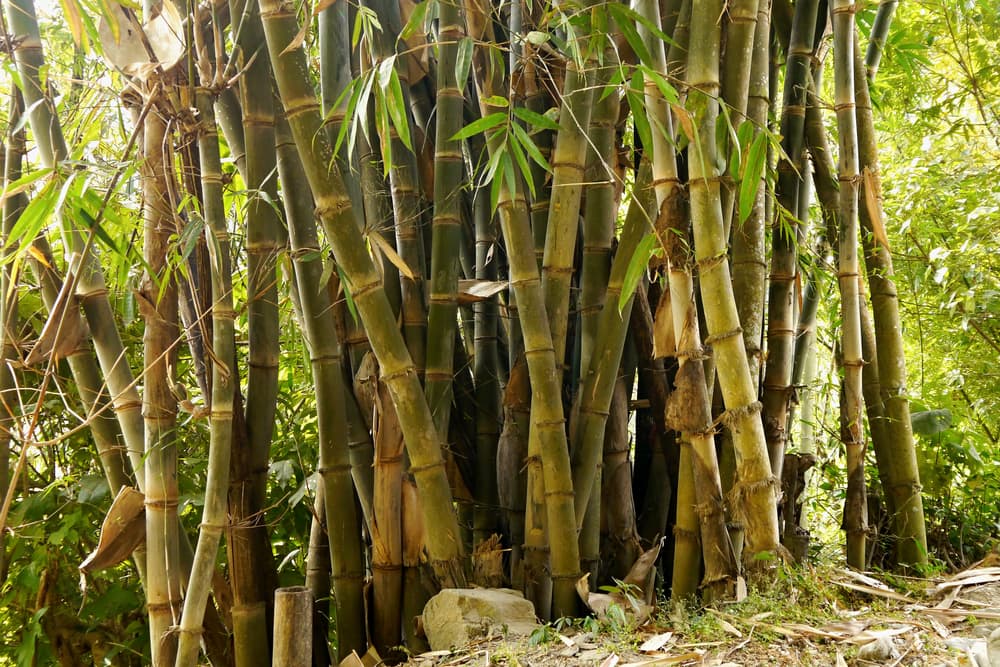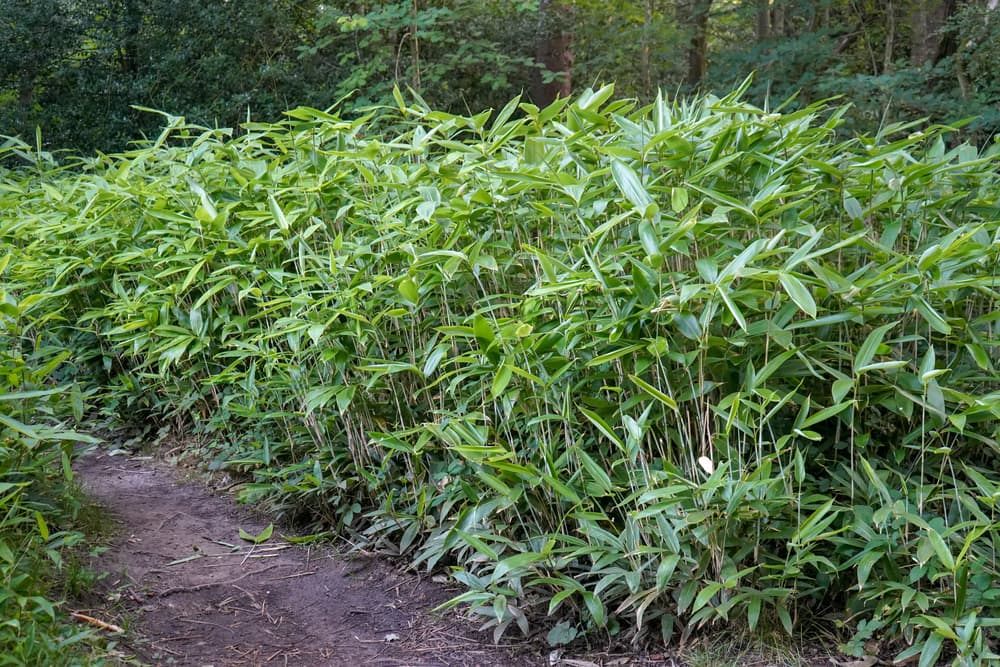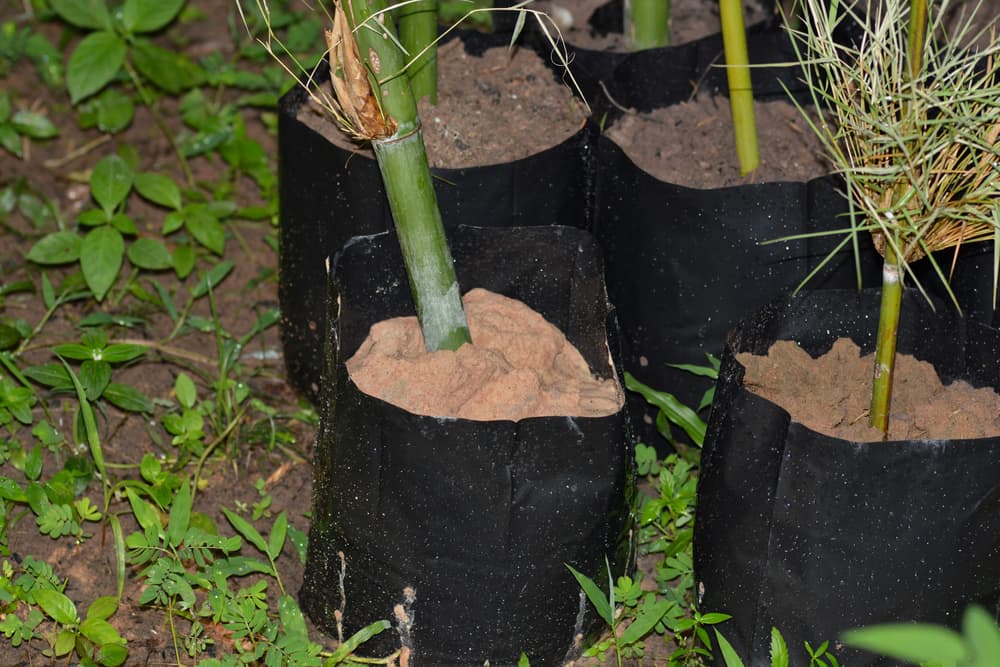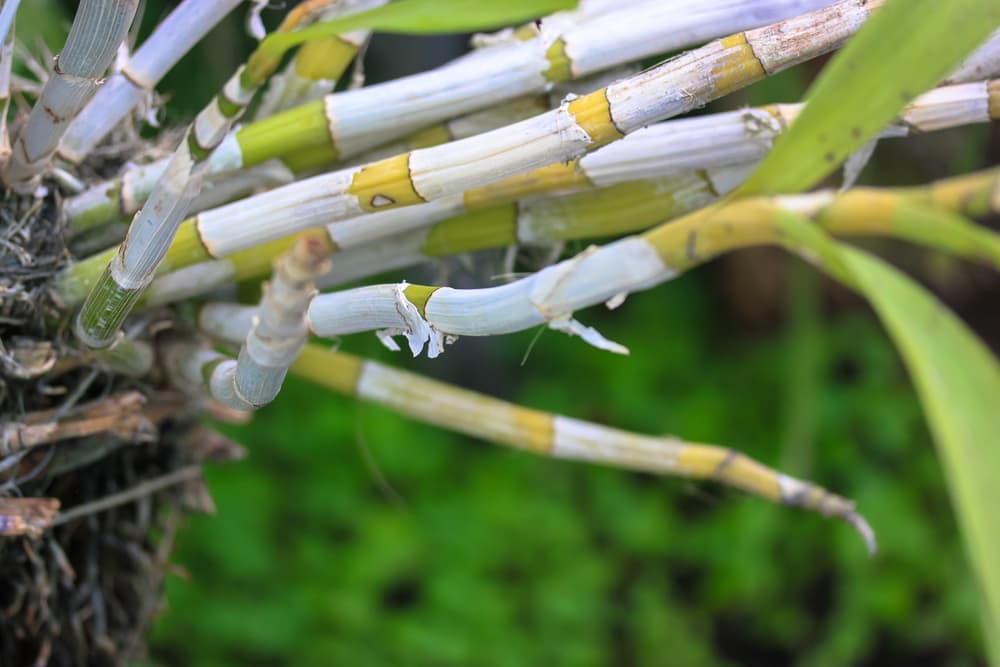PERENNIALS > BAMBOO
Reviewed By COLIN SKELLY

Colin is a Horticulturist and Horticultural Consultant with experience in a range of practical and managerial roles across heritage, commercial and public horticulture. He holds the Royal Horticultural Society’s Master of Horticulture award and has a particular interest in horticultural ecology and naturalistic planting for habitat and climate resilience.
Contributions From KERRI DALL
IN THIS GUIDE
The simple, cool, almost austere beauty of bamboo is an example of Nature’s own original version of ‘Swedish Design’ – except that bamboo is China through and through.
This tree is of enormous cultural significance in China and even other Far Eastern countries.
In this guide we share how to grow and care for bamboo plants in British gardens, including some tips from our interview with Kerri Dall, the owner of Scottish Bamboo.
“Living in rural Aberdeenshire in Northeast Scotland, we wanted to create a lush, evergreen, jungle-style garden to give us all year-round interest in our garden”, explains Kerri.
“However, with a very inclement & temperamental climate and cold winters often reaching -10°C or below on a regular basis, we needed to ensure we were growing exceptionally hardy plants.
“We found bamboo to be incredibly hardy, and our 2-acre garden soon became a tropical haven. This started as a garden hobby but we turned our love for bamboo into our business in 2008”.
Overview
| Botanical Name | Bambusoideae |
| Common Name(s) | Bamboo |
| Plant Type | Perennial |
| Native Area | Americas, Tropical Africa, Asia |
| Hardiness Rating | H6-H7 |
| Foliage | Varied shoots, running or clump-forming types |
| Flowers | Flowering variable and infrequent |
| When To Sow | March, April, May |
| When To Prune | March, April |
Sunlight
Preferred
Various
Exposure
Varies
Size
Height
0.3 – 20M
Spread
Varies
Soil
Preferred
Most Soil Types
Moisture
Moist but well drained
pH
Any (some require acidic)
The perfectly cylindrical, jointed, cool green shafts of bamboo are instantly recognisable.
What is probably not instantly recognisable is that bamboo is a member of the grass family, Poaceae.
Yes, bamboo is botanically and taxonomically related to grasses – the grass of your lawn, grasslands, meadows, and savannahs.1Yeasmin, L., Ali, M. N., Gantait, S., & Chakraborty, S. (2015). Bamboo: an overview on its genetic diversity and characterization. 3 Biotech, 5(1), 1–11. https://doi.org/10.1007/s13205-014-0201-5
The bamboo sub-family Bambusoideae comprises of three ‘tribes’ and a total of 1,675 species.2Bamboo Genera. (n.d.). ECHO Community. Retrieved March 13, 2023, from https://www.echocommunity.org/en/resources/cf9deeb0-620e-487e-8c43-9fbc9e3b0381

Most species of this evergreen perennial flourish in humid and warm conditions in temperate and tropical climates.
However, other species grow in somewhat more extreme climates such as the cold montane regions of the Himalayas and the hot tropical hills of Central America.3Hornaday, F. (2022, May 26). Bamboo in the mountains: Reaching record elevations. Bambu Batu: The House of Bamboo. Retrieved March 13, 2023, from Hornaday, F. (2022, May 26). Bamboo in the mountains: Reaching record elevations. Bambu Batu: The House of Bamboo. Retrieved March 13, 2023, from https://bambubatu.com/bamboo-in-the-mountains-high-elevations/
It is a very hardy plant and various species bring an unlikely Far-Eastern touch across much of Europe, including the United Kingdom.

This woody grass bears flowers but does so even less frequently than that proverbial blue moon is seen; most species flower once every 60-120 years.4Shimbun, S. (2021, June 18). Once in a Century bamboo blossoms observed in western Japan. Kyodo News. Retrieved March 13, 2023, from https://english.kyodonews.net/news/2021/06/232628087928-once-in-a-century-bamboo-blossoms-observed-in-western-japan.html
One cannot predict when a bamboo tree will burst into flower.
Bamboo habitat stretches in a band across the world through its temperate and tropical zones.

Each bamboo genus has a particular, preferred habitat which may be of vastly different areas in size.
Though it may seem surprising, many clumping and running types of bamboo are hardy to H7 and their root systems and rhizomes can withstand temperatures well below freezing – down to about -30°C.
Over the years, various species of bamboo have been introduced in Europe and the United States.

Large species whose culms have high tensile strength, for example Guadua angustifolia, are grown on commercial farms for construction purposes.
Small species which are visually appealing, e.g. Chusquea culeou ‘Cana Prieta’, are cultivated in nurseries for ornamental uses.
Where To Grow Bamboo
If you’re looking to grow bamboo in your garden for the first time, Kerri Dall recommends considering the right bamboo for the right place in your garden.
“Think about what height you want the bamboo to reach when it is fully grown and choose one which doesn’t grow any larger than what you require.
“If you want to grow bamboo as a hedge or a screen, plant the bamboo as small plants, space them around 1m apart and, within 3-5 years, you will have a reasonably established screen”.
How To Grow Bamboo
Matching bamboo’s ever-increasing popularity, an ever-rising number of suppliers sell quite a number of species of the plant.
Nurseries like Scottish Bamboo sell potted bamboo plants as online sellers, specialising in specific bamboo varieties.

Online nurseries sell various species of bamboo for different purposes including screening and fencing, planting in large gardens, and for indoor ornamental purposes.
You are not limited to acquiring bamboo by way of purchase; bamboo very sportingly propagates from cuttings.
Growing From Cuttings
Taking cuttings from the many varieties of garden bamboo is fairly straightforward.
A cutting can be taken from a plant’s culm as well as from emerging new growth.

Autumn is the best season both to prune bamboo and take cuttings as well as to plant cuttings.
- First, take a clean pair of pruners or loppers.
- To take cuttings from a culm, choose a mature plant (whose culm is) at least 30cm tall, preferably more.
- Take a cutting from the top of the culm. The cutting should be about 10cm and include at least one node and at least one internode. It should not be more than one-third the height of the plant, preferably less.
- Dip the cutting in root hormone liquid and plant it in the appropriate type of soil.
You can also take cuttings from new growth that is emerging from the ground:
- Take a cutting 20-25cm in length, making the cut at a 45-degree angle.
- Put it in a transparent pot filled with water and let it remain for one to two weeks, while you observe whether and how well the cutting is taking root.
- Change the water in the pot every alternate day.
- Assuming the cutting is rooting, prepare a planting pot or an outdoor bed with the type of soil most suited to bamboo and plant the cutting.
Growing From Rhizomes

Autumn is the best season to grow bamboo from rhizomes, though early spring after the last frost is also a good time.
- Using a trowel and a spade dig up the soil and expose a rhizome.
- Using a craft knife or other knife with a sharp edge cut off a piece that has about three growth buds.
- Clean the dirt and soil off the ends using a soft cloth and water.
- Plant it horizontally in a pot, buds facing up, under a layer of soil 6-8cm.
- Sprinkle water using a watering can but only to the extent of making the soil damp all through as overwatering can cause the rhizome cutting to rot.
- Water it every two days in a similar fashion.
- Keep the pot in the shade and away from direct or full sun but in a warm place.
- You may sprinkle a teaspoon of fertiliser with high phosphorous content.
- After about five weeks, break the pot and transplant the rooting rhizome into the selected spot in your garden.
Because the rhizome needs to be protected from sunlight, transplant it well after sunset.
Bamboo Care
With over 1,400 species divided into three distinct tribes, and with stark differences between species, no single set of care and growing tips can account for all of Bamboodom.5The Editors of Encyclopaedia Britannica. (2023c, February 9). Bamboo | plant. Encyclopedia Britannica. Retrieved March 13, 2023, from https://www.britannica.com/plant/bamboo
In the main, bamboos do not require extensive care.
Watering
Young bamboo plants need to be watered regularly and amply; mature bamboo trees growing in open ground do not need to be watered as frequently.
“When first planting bamboo in the garden, the most important care you can give the plant is water. Bamboo plants are quite thirsty for water when first planted, but soon begin to look after themselves when they’re settled in” says Kerri.

Potted bamboo needs to be watered more often; in hot or dry weather water it three or four times a week.
If your bamboo plant’s leaves curl inward, it is telling you it needs more water.
Soil Requirements
Grow your potted bamboo in nutrient-rich soil with a pH of between 6 and 7.
Bamboo does not tolerate waterlogged conditions so make sure that your soil drains well.
As long as your soil has good drainage, over-watering will not cause any harm to your bamboo.
Sunlight & Temperature
Most species of bamboo prefer more sun than shade so try to ensure that potted bamboos get sufficient sun.

If you want to go the extra mile, mist your potted bamboos every other day or keep a humidifier nearby as most bamboos thrive in humid conditions.
Applying mulch to your bamboo is dually advantageous if you experience temperature extremes.
In hot or dry weather, mulch prevents rapid evaporation of soil moisture.
During cold snaps, mulch saves rhizomes and roots from freezing and possibly dying.
Fertilising
On feeding bamboo, Kerri advises: “Feeding at least once a year in Spring is recommended.
“Bamboos love chicken muck or any other type of manure. I’d also recommend feeding every 2 weeks during the summer months, especially if you are trying to establish a screen or hedge with your bamboo”.
You could allow dead leaves to remain where they fall; when they decompose they provide a natural mulch to their mother plant.
Most species of bamboo are nitrogen-hungry so use some 10-5-5 fertiliser or go for an organic fertiliser consisting of blood meal with composted coffee grounds and vegetable refuse.
How Fast Does Bamboo Grow?
Bamboo has a well-deserved reputation for being one of the Plant Kingdom’s fastest-growing members.
Bamboo growth is neither uniform nor consistent; it is dependent upon a few factors such as species, soil, water and climate.

That explained, commonly-grown species in temperate regions can grow up to 9 or 10cm in a single day during the growing season.
According to Guinness World Records, bamboo is not just a contender, it is the Plant Kingdom’s undisputed speed champion: unnamed species have been clocked at 91cm of growth in 24 hours (and that too in the United Kingdom).6Fastest growing plant. (n.d.). Guinness World Records. Retrieved March 13, 2023, from https://www.guinnessworldrecords.com/world-records/fastest-growing-plant
That works out to an average growth rate of 3.8cm per hour.
In China, it is an annual occurrence for Phyllostachys edulis (‘Moso’) to emerge from the ground every spring and within a few weeks reach a height of up to 75cm.
It is large bamboo species’ uniquely fast growth rates that, combined with these species’ great strength and versatility, making them the ‘go-to’ tree for many kinds of building and construction materials.

Common Problems
Bamboos outside their native habitats and especially those kept indoors are susceptible to diseases and insects.
If you spot an insect infestation, use a thick swab dipped in insecticidal soap solution to wash the leaves.
Do not apply the soap to the underside of the leaves if the insects are only on the upward side, and do not wash all the leaves on the same day.

Increase the airflow and, if the plant is not already under full sun, increase its exposure to the sun.
Yellow patches at or near the base of the plant may signal a fungus attack.
In gardens and other cultivated settings, incorrect exposure or watering, or improper care may well result in problems.
While underwatering can be a cause of concern, its effects can easily be reversed by increasing the amount of water given to the plant.
Much more dangerous is overwatering, especially when the soil has poor drainage.

This deadly combination can cause the roots and rhizomes to begin to rot.
Other problems occur when exposure to the sun is too little or too much for the species in question.
Too much sun will cause the leaves to scorch and die, affecting the rest of the plant.
(‘Lucky bamboo’ is not, in fact, bamboo and so its well-known problem of rot caused by over-submergence is not discussed here.)
How To Get Rid Of Unwanted Bamboo
Bamboo has a reputation for becoming unwanted in gardens,” shares Colin Skelly, an expert in all things horticulture.
“I’ve removed many over the years, using diggers as well as spades.
“The right bamboos in the right place make fantastic and versatile garden plants, but do your homework.
“Ideally, see the plant you think you want to grow in a similar setting.
“Once planted, if it does look like you may want to revise your thinking and remove it, act before it really gets going.”
You can get rid of unwanted bamboo using mechanical methods or chemical processes.
However, we cannot in good conscience recommend any herbicides let alone glyphosate.

We outline a mechanical method by which you can clear your plot of bamboo.
- First, cut back all the culms to the ground.
- When the cut-back culms emerge again, wait until they are about 60cm high, then cut them back again.
- Repeat three times. This repeated cutting will exhaust the plant’s subsoil food reserves so that it is weakened or even dies.
- Next, water the soil very well to the extent of waterlogging it, and keep it waterlogged.
- Using a spade, shovel, and hoe as appropriate, dig up the soil and grub out all the rhizomes and root systems you can find.
- Use a heavy rake to ‘dredge’ the soil of any hard-to-find rhizomes.
- Finally, pour ample boiling water in the plot to be cleared.
When invasive species of running bamboo take over a parcel of land, they can be very difficult to eliminate because of their underground network of rhizomes and root systems.
Sometimes the last resort and only resort is to plough up the land.
References
- 1Yeasmin, L., Ali, M. N., Gantait, S., & Chakraborty, S. (2015). Bamboo: an overview on its genetic diversity and characterization. 3 Biotech, 5(1), 1–11. https://doi.org/10.1007/s13205-014-0201-5
- 2Bamboo Genera. (n.d.). ECHO Community. Retrieved March 13, 2023, from https://www.echocommunity.org/en/resources/cf9deeb0-620e-487e-8c43-9fbc9e3b0381
- 3Hornaday, F. (2022, May 26). Bamboo in the mountains: Reaching record elevations. Bambu Batu: The House of Bamboo. Retrieved March 13, 2023, from Hornaday, F. (2022, May 26). Bamboo in the mountains: Reaching record elevations. Bambu Batu: The House of Bamboo. Retrieved March 13, 2023, from https://bambubatu.com/bamboo-in-the-mountains-high-elevations/
- 4Shimbun, S. (2021, June 18). Once in a Century bamboo blossoms observed in western Japan. Kyodo News. Retrieved March 13, 2023, from https://english.kyodonews.net/news/2021/06/232628087928-once-in-a-century-bamboo-blossoms-observed-in-western-japan.html
- 5The Editors of Encyclopaedia Britannica. (2023c, February 9). Bamboo | plant. Encyclopedia Britannica. Retrieved March 13, 2023, from https://www.britannica.com/plant/bamboo
- 6Fastest growing plant. (n.d.). Guinness World Records. Retrieved March 13, 2023, from https://www.guinnessworldrecords.com/world-records/fastest-growing-plant



